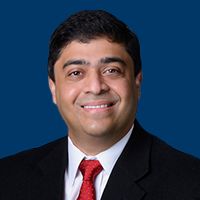Video
Targetable Mutations and Rearrangements in Lung Cancers
Author(s):
Expert participants share their perspective on the advent of precision medicine in lung cancer, following the discovery of several key driver mutations and alterations.
EP: 1.Targetable Mutations and Rearrangements in Lung Cancers
EP: 2.Targetable Mutations Found in Breast Cancers
EP: 3.Addressing Barriers to Adequate Biomarker Testing in Cancer Care
EP: 4.Optimizing Cancer Care: Interpreting and Communicating Biomarker Testing Results
EP: 5.Armamentarium of Biomarker Testing Strategies in Cancer Care
EP: 6.Updating Biomarker Testing Strategies as Cancer Care Evolves
EP: 7.Optimizing the Timing and Utilization of Biomarker Testing in Cancer Care
EP: 8.Improving Uptake of Biomarker Testing and Precision Medicine in Cancer Care
EP: 9.The Value of Molecular Tumor Boards and Multidisciplinary Care
EP: 10.Role of a Pharmacist in the Multidisciplinary Approach to Identifying Biomarkers
EP: 11.Role of a Pharmacist in Developing Treatment Pathways and Educating Patients
EP: 12.Future Directions in Precision Medicine: An Evolving Treatment Landscape
Transcript:
Timothy J. Pluard, MD:Hello, and welcome to our OncLive® Seminar Series. Today we’re going to discuss “Precision Medicine: A Collaborative and Multidisciplinary Approach for Identifying Biomarkers.” I’m joined by 2 of my colleagues, Dr Ossama Tawfik and Dr Sujith Kalmadi. I’ll let them briefly introduce themselves, and then we’ll get started. Dr Kalmadi?
Sujith R. Kalmadi, MD: Thanks, Tim. I’m Sujith Kalmadi, and I’m the chief medical officer of Ironwood Cancer & Research Centers in Phoenix, Arizona. We’re a group of about 75 oncology-directed physicians at a private, physician-owned practice. I’ve run active clinical protocols in about 40 trials. I’m also on the faculty at Creighton [University School of Medicine in Omaha, Nebraska] and Midwestern [University in Downers Grove, Illinois]. Prior to coming here, I was a medical oncologist at Cleveland Clinic [Lerner College] of Medicine and Baylor College of Medicine [in Houston, Texas]. Thanks for having me.
Timothy J. Pluard, MD:Thanks, Sujith. Ossama?
Ossama Tawfik, MD: First, thank you for the invitation. It’s my pleasure to be with you discussing something I’m very passionate about. I’m a practicing pathologist in private practice at the MAWD Pathology Group [in Lenexa, Kansas]. It’s a group of 55 pathologists in the heart of America, in Kansas and Missouri. Before that, I was a professor of pathology at the University of Kansas [School of Medicine]. In between, I had the pleasure of working with Dr Pluard at St Luke’s Health System in Kansas City [Kansas] in my capacity as a chair of pathology. I’ve spent my entire career doing research on cancer biomarkers, so I have tremendous interest in this field.
Timothy J. Pluard, MD:Thank you, Ossama. Let’s get started. We’re going to discuss the emerging field of biomarker testing to identify patients who may benefit from targeted therapy. We’re going to focus on identifying patients and executing the testing to allow them to receive these targeted agents and focus on the collaboration that needs to occur between clinicians and pathologists to facilitate testing in a timely and efficient manner we need in order to identify potential targeted therapies.
To get started let’s talk a little about biomarker identification and testing. Over the last few years we’ve seen proliferation of new biomarkers in various diseases, some of which the biomarkers cross particular tissue sites and some where they’re unique to anatomic locations. Let’s talk a little about how we identify and determine an appropriate biomarker test. Sujith, give us a little background on biomarker testing in lung cancer, which was 1 of the first where we started to see a proliferation of a number of biomarkers. Tell us a little about what you think about it in terms of testing in lung cancer for biomarkers.
Sujith R. Kalmadi, MD: I started in medical oncology over 15 years ago at Cleveland Clinic…. Little did I know there was going to be an explosion of new therapies. The first thing that happened was that we were able to subdivide adenocarcinoma and squamous cell carcinoma based on the data of Alimta, or pemetrexed. That was the first histopathologic differentiation. Till then, it was all just lung cancer. Then along came a slew of biomarkers. First was EGFR, then came ALK, ROS1, BRAF, NTRK, and RET mutations. Finally, there was the explosion of immunotherapy. We’re able to treat lung cancer with immunotherapy and no chemotherapy in patients with PD-L1-high expression. Those with a PD-L1 expression of 90% do so well with immunotherapy alone. You could make a case for high PD-L1 expression being treated with immunotherapy alone with a PD-L1 more than 50%.
We have 3 kinds of testing: germline mutation testing, which is not very relevant in lung cancer; somatic mutation on the tissue; and the circulating tumor DNA assessing the somatic mutation, which came about 3 or 4 years ago. Today in lung cancer, 70% of the time we get an answer with somatic tissue testing. We use several platforms. In 20% to 30% of cases, we’re not able to get adequate tissue, so we rely on circulating tumor DNA to give us the answer. The yield is 70% to 80% in circulating tumor DNA. We’re able to get a very comprehensive view of what we’re treating in lung cancer.
Timothy J. Pluard, MD:Thank you.
Samuel K. Caughron, MD, FCAP: The targetable mutations, including rearrangements in lung cancer, are numerous and growing. We have the traditional more common mutations that we’ve been testing for some time, including EGFR, KRAS, BRAF, ALK, and ROS1. Add to that list newer mutations, including PIK3CA, NTRK, RET, MET, and BRAF. Then you can expand that to emerging genes and mutations. The pipeline from multiple pharmaceutical companies for therapies that are going to be matched with a specific mutation or rearrangement is significant. What’s important to recognize is that there’s a list today, but that list is dynamic and growing. You need to test using an approach that’s going to identify as many of those as possible but also adapt to the new mutations as they emerge.
Transcript edited for clarity.








